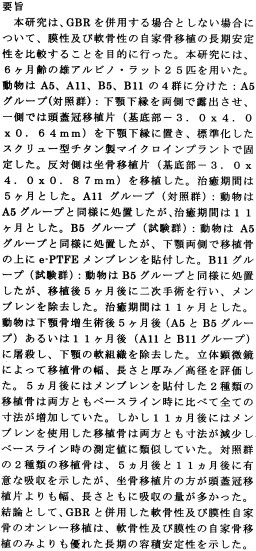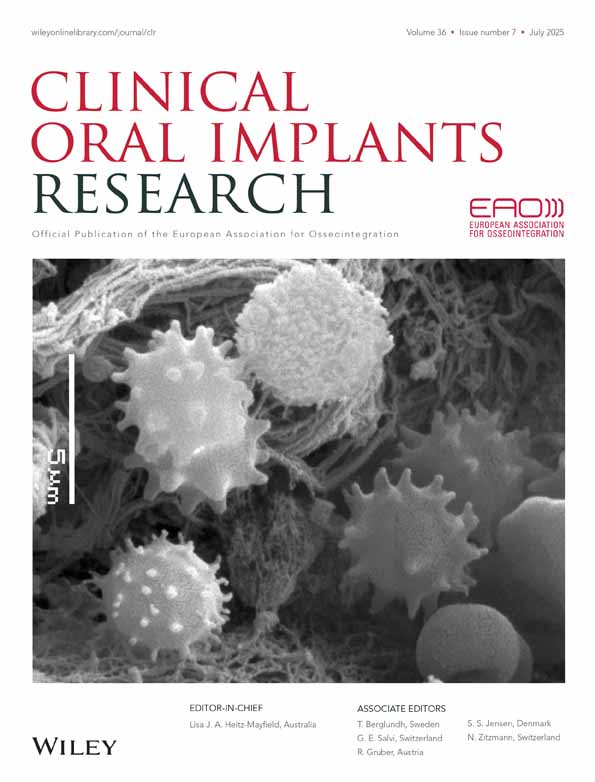Long-term stability of autogenous bone grafts following combined application with guided bone regeneration
Langzeitstabilität von autologen Knochentransplantaten nach kombinierter Applikation mit GBR
Abstract
enAbstract: The aim of the study was to compare the long-term stability of membranous and endochondral autogenous bone grafts with or without combined application of guided bone regeneration (GBR). Twenty-five, male, 6-month old, albino rats were used in the study. The animals were divided into four groups (A5, A11, B5 and B11). Group A5 (control): The inferior border of the mandible was exposed in both sides. At one side of the jaw, a calvarial bone graft (baseline −3 × 4 × 0.64 mm) was placed at the inferior border of the mandible and was fixed with a standardized screw-type titanium microimplant. At the contralateral side, an ischiac bone graft (baseline −3 × 4 × 0.87) was transplanted. The healing period was 5 months. Group A11 (control): The animals were treated in the same manner as in Group A5 with the difference that the healing period was 11 months. Group B5 (test): The animals were treated in the same manner as in Group A5 with the difference that an e-PTFE membrane was adapted over the bone graft on each side of the jaw. Group B11 (test): The animals were treated in the same manner as in Group B5 with the difference that 5 months following transplantation the animals were subjected to a second operation and the membranes were removed. The healing period was 11 months. The animals were killed at 5 (Groups A5 and B5) or at 11 months (Groups A11 and B11) following mandibular augmentation and the jaws were defleshed. The width, the length and the thickness/height of the bone graft were evaluated by means of a stereomicroscope. At 5 months, both types of the membrane-treated bone grafts presented increase in all dimensions compared with baseline. However at 11 months, both types of the membrane-treated bone grafts exhibited a decrease in their dimensions which were similar to the baseline measurements. In the control groups, both types of bone graft presented significant resorption both at 5 and at 11 months with the ischiac bone grafts presenting more resorption in width and length than the calvarial bone grafts. It can be concluded that the long-term volume stability of autogenous endochondral and membranous onlay bone grafts combined with GBR is superior to that of autogenous endochondral and membranous onlay bone grafts alone.
Résumé
frLe but de cette étude a été de comparer la stabilitéà long terme de greffons osseux autogènes et endochondrieux et membraneux avec ou sans l'application combinée de ROG. Vingt-cinq rats albinos mâles de six mois ont été répartis en quatre groupes (A5, A11, B5 et B11): groupe A5 (contrôle). Le bord de la mandibule a été exposé des deux côtés. D'un côté de la mâchoire un greffon osseux du crâne (au départ 3,0 × 4,0 × 0,64 mm) a été placé au bord inférieur de la mandibule et fixéà l'aide d'un micro-implant de titane en forme de vis standardisé. Du côté contralatéral, un greffon osseux du bassin (au départ 3,0 × 4,0 × 0,87 mm) a été transplanté. La période de guérison a duré cinq mois. Le groupe A11 (contrôle): les animaux ont été traités de la même manière que dans le groupe A5 à la différence que la guérison était de onze mois. Le groupe B5 (test) : les animaux étaient traités de la même manière que dans le groupe A5 à la différence qu'une membrane en téflon a été adaptée sur le greffon osseux de chaque côté de la mâchoire. Le groupe B11(test) : les animaux ont été traités de la même manière que dans le groupe B5 à la différence que cinq mois après la transplantation les animaux étaient soumis à une seconde opération et que les membranes ont été enlevées. La période de guérison a été de 11 mois. Les animaux ont été euthanasiés à cinq (groupe A5 et B5) ou 11 mois (A11 et B11) suivant ce processus d'épaississement de la mandibule et les mâchoires ont été enlevées. La largeur, la longueur et l'épaisseur/hauteur du greffon osseux ont étéévaluées au microscope. Après cinq mois les deux types de greffon osseux traités avec membranes présentaient un épaississement dans toutes les dimensions comparés au départ. Après onze mois, les deux types de greffons osseux traités avec membranes montraient une diminution de leur dimension qui étaient semblables aux mesures de départ. Dans les groupes contrôles, les deux types de greffons osseux présentaient une résorption significative tant à cinq qu'à onze mois, avec les greffons provenant de l'os du bassin présentant davantage de résorption en largeur et longueur que les greffons osseux du crâne. La stabilité du volume à long terme des greffons osseux autogènes endochondrieux et membraneux combinés avec la ROG est supérieure à celle des greffons osseux membranaires et endochondrieux autogènes seuls.
Zusammenfassung
deDas Ziel dieser Studie war, die Langzeitstabilität von membranösen und enchondralen autologen Knochentransplantaten mit oder ohne kombinierte Anwendung der GBR zu vergleichen. Es wurden 25 männliche, 6 Monate alte Albinoratten für die Studie verwendet. Die Tiere wurden in 4 Gruppen eingeteilt (A5 A11, B5 & B11): Gruppe A5 (Kontrolle): Der untere Rand des Unterkiefers wurde auf beiden Seiten dargestellt. Auf einer Seite des Kiefers wurde ein Knochentransplantat von der Kalvaria (Ausgangsuntersuchung −3 × 4 × 0.64 mm) am unteren Rand der Mandibula platziert und mit einem standardisierten schraubenförmigen Mikroimplantat aus Titan befestigt. Auf der gegenüberliegenden Seite wurde ein Knochentrasplantat vom Beckenkamm (Ausgangsuntersuchung −3 × 4 × 0.87 mm) eingebracht. Die Heilungszeit betrug 5 Monate. Gruppe A11 (Kontrolle): Die Tiere wurden auf dieselbe Art behandelt wie in Gruppe A5, jedoch betrug die Heilungszeit 11 Monate. Gruppe B5 (Test): Die Tiere wurden auf dieselbe Art behandelt wie in Gruppe A5, jedoch wurde zusätzlich auf beiden Seiten des Kiefers eine e-PTFE Membran über den Knochentransplantaten angebracht. Gruppe B11 (Test). Die Tiere wurden auf dieselbe Art behandelt wie in Gruppe B5, jedoch wurden die Tiere 5 Monate nach der Transplantation einer zweiten Operation unterzogen, in der man die Membranen entfernte. Die Heilungszeit betrug 11 Monate. Die Tiere wurden 5 (Gruppen A5 & B5) bzw. 11 Monate nach der Augmentation der Unterkiefer (Gruppe A11 & B11) getötet und man entfernte die Weichteile der Kiefer. Mit einem Stereomikroskop bestimmte man die Breite, die Länge und die Dicke/Höhe der Knochentransplantate. Nach 5 Monaten zeigten beide Arten der membranbehandelten Transplantate im Vergleich zur Ausgangsuntersuchung eine Zunahme in allen Dimensionen. Nach 11 Monaten jedoch zeigten beide Arten der membranbehandelten Knochentransplantate eine Abnahme in allen Dimensionen. Die Grössen der Transplantate waren ähnlich wie bei der Ausgangsuntersuchung. In den Kontrollgruppen zeigten beide Arten der Knochentransplantate sowohl nach 5 als auch nach 11 Monaten signifikante Resorptionen. Die Knochentransplantate vom Beckenkamm wiesen mehr Resorptionen in der Breite und in der Länge auf als die Transplantate von der Kalvaria.
Es kann die Schlussfolgerung gezogen werden, dass die Langzeit-Volumenstabilität von autologen enchondralen und membranösen aufgelegten Knochentransplantaten in Kombination mit GBR besser ist als bei enchondralen und membranösen aufgelegten Knochentransplantaten allein.
Resumen
esLa intención de este estudio fue comparar la estabilidad a largo plazo de injertos de hueso autógeno membranoso y endocondral con o sin la aplicación combinada de GBR. Se usaron en este estudio veinticinco ratas albinas machos, de 6 meses de edad. Los animales se dividieron en cuatro grupos (A5, A11, B5 y B11): Grupo A5 (Control): El borde inferior de la mandíbula se expuso en ambos lados. En un lado de la mandíbula, se colocó un injerto de hueso del calvario (al inicio −3.0 × 4.0 × 0.64 mm) en el borde inferior de la mandíbula y se fijó con un microimplante estándar tipo-tornillo de titanio. En el lado contralateral se transplantó un hueso isquial (al inicio −3 × 4 × 0.87). El periodo de cicatrización fue de 5 meses. Grupo A11 (control): Los animales fueron tratados de la misma manera que en el Grupo A5 con la diferencia de que el periodo de cicatrización fue de 11 meses. Grupo B5 (prueba): Los animales fueron tratados de la misma manera que en el Grupo A5 con la diferencia que se adaptó una membrana de e-PTFE sobre el injerto óseo en cada lado de la mandíbula. Grupo B11 (prueba): Los animales se trataron de la misma manera que en el grupo B5 con la diferencia que entras 5 meses del transplante los animales se sometieron a una segunda operación y se retiraron las membranas. El periodo de cicatrización fue de 11 meses. Los animales se sacrificaron a los 5 meses (Grupos A5 y B5) o a los 11 meses (Grupos A11 y B11) tras el aumento mandibular y las mandíbulas se descarnaron. Se evaluaron la longitud y el grosor/altura del injerto óseo por medio de estereomicroscopía. A los 5 meses, ambos tipos de injertos tratados con membranas presentaron incrementos de todas la dimensiones comparadas con el inicio. A los 11 meses, sin embargo, ambos tipos injertos tratados con membranas presentaron un descenso en sus dimensiones que fueron similares a las mediciones del inicio. En el grupo de control, ambos tipos de injertos óseos presentaron una reabsorción significativa tanto a los 5 como a los 11 meses con el hueso isquial presentando más reabsorción en anchura y longitud que los injertos de hueso calvario. Se puede concluir que la estabilidad volumétrica a largo plazo de injertos de hueso autógeno endocondral y membranoso combinados con GBR es superior a aquella de los injertos óseos autógenos endocondrales y membranosos solos.





